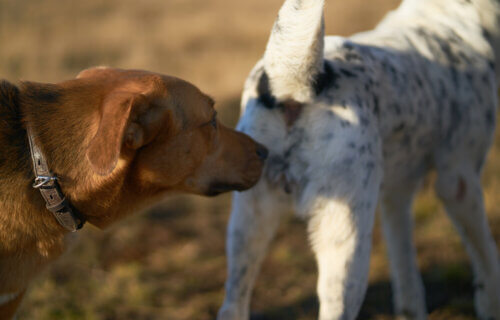CAMBRIDGE, United Kingdom — We’ve all had a chuckle at the sight of two dogs sniffing each other’s behinds. It’s a humorous sight for us humans, but doing so actually helps pups get to know each other quite well. Now, unfortunately, new research reports that sniffing or licking other dogs’ genitalia can spread an unusual cancer called Canine Transmissible Venereal Tumor from one pups’ private parts to another’s nose or mouth.
Importantly, the findings from the University of Cambridge also show that male dogs are four to five times more likely than female pups to be infected with the oro-nasal variety of Canine Transmissible Venereal Tumor (CTVT). Why such a major discrepancy between genders? Well, male dogs tend to spend a whole lot more time licking and sniffing female dogs’ genitalia than the other way around.
CTVT is quite infectious and capable of spreading between dogs via physical contact. The living cancer cells actually physically “transplant” themselves from one dog to another. Most of the time, CTVT is spread during intercourse and impacts dogs’ genitals, but in some cases it spreads to the nose, mouth, and skin.
For this project, researchers analyzed a database of almost 2,000 cases of CTVT from all over the world and noted only 32 CTVT tumors affecting the nose or mouth. Among those 32 cases, 27 were in male dogs.
“We found that a very significant proportion of the nose or mouth tumors of canine transmissible cancer were in male dogs,” says first study author Dr. Andrea Strakova in the University of Cambridge’s Department of Veterinary Medicine, in a statement.. “We think this is because male dogs may have a preference for sniffing or licking the female genitalia, compared to vice versa. The female genital tumors may also be more accessible for sniffing and licking, compared to the male genital tumors.”
How common is CTVT in dogs?
This odd cancer dates back thousands of years ago to a single dog. Incredibly, the cancer survived beyond the death of this original dog and has been spreading from canine to canine ever since. Today, it is present in canine populations all over the globe, and considered the oldest and most prolific cancer lineage known in nature. That said, it’s most prevalent in countries with free-roaming dog populations.
“Although canine transmissible cancer can be diagnosed and treated fairly easily, veterinarians in the UK may not be familiar with the signs of the disease because it is very rare here,” Dr. Strakova adds. “We think it’s important to consider CTVT as a possible diagnosis for oro-nasal tumors in dogs. Treatment is very effective, using single agent Vincristine chemotherapy, and the vast majority of dogs recover.”
Common symptoms associated with the oro-nasal form of CTVT include difficulty breathing, sneezing, snoring, nasal deformation, and bloody/other discharge from the nose or mouth.
The study is published in Veterinary Record.

Does this info apply to humans?
I wonder how does this relate to dogs licking its owners faces, and mouths, after they get to lick this contagious cancer on dog bits ? No wonder I absolutely hate when they try to lick my face, and prevent it at all times.
My female Pomeranian was old and had a tumor on her rear end. My 2 year old male rottweiller one night killed my Pomeranian, by eating her rear end. Awful, I buried her , but my rottweiller still sniffed her out and ate her. Very sad and disgusting. My rottweiller is now 3, as it’s been a year, and he now has the same type tumor about inch long under his tail by anus. Just like my Pomeranian. Did he get that by eating her tumor, or maybe was it contagious by sitting where she sat?